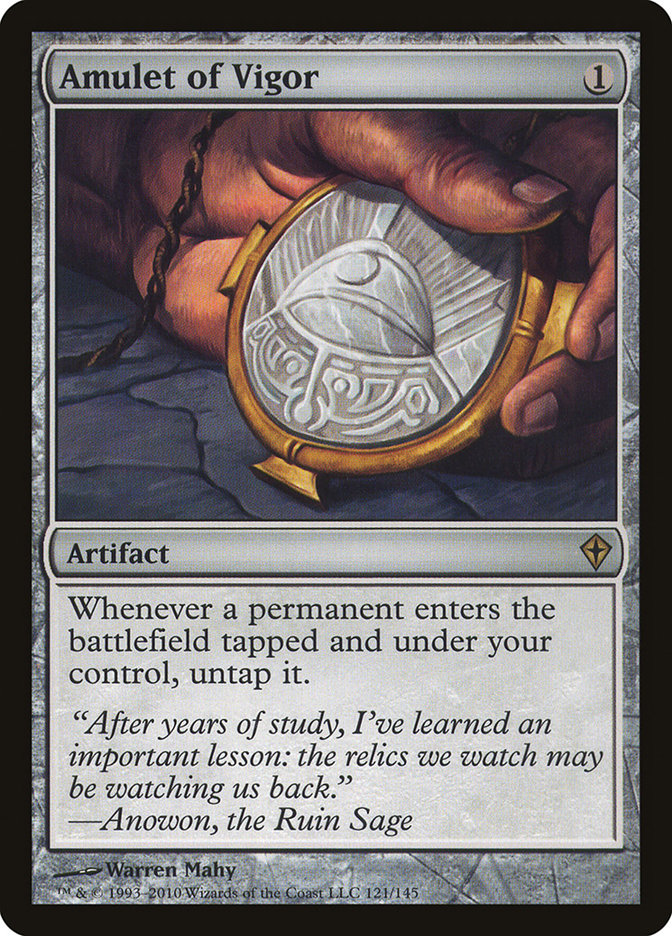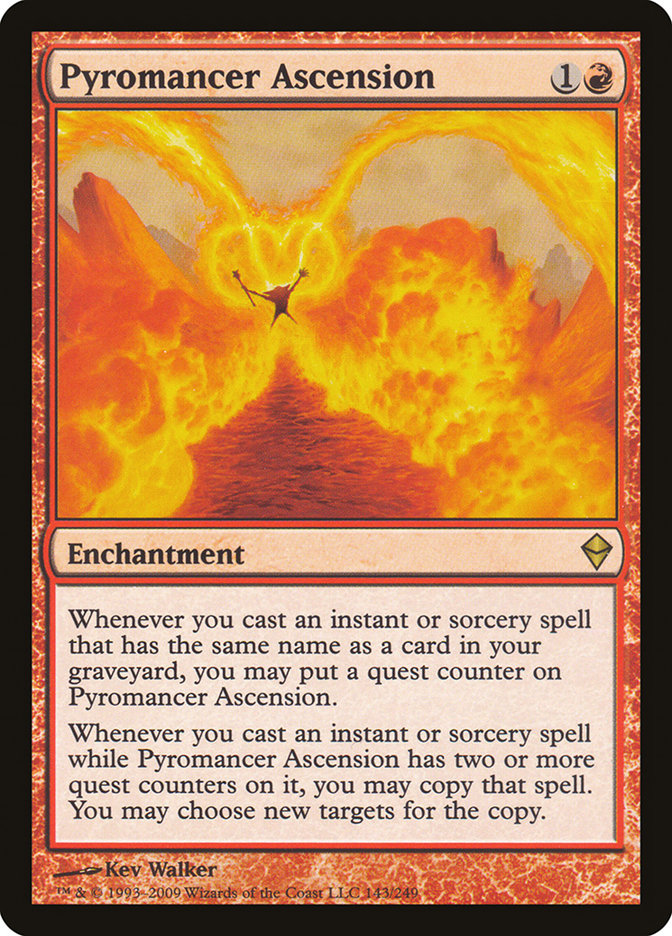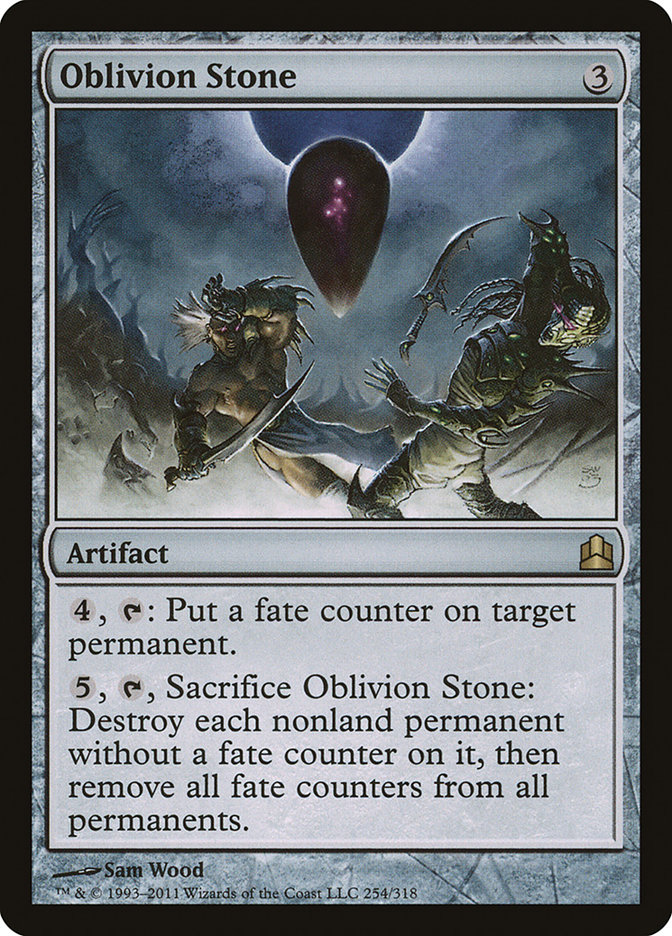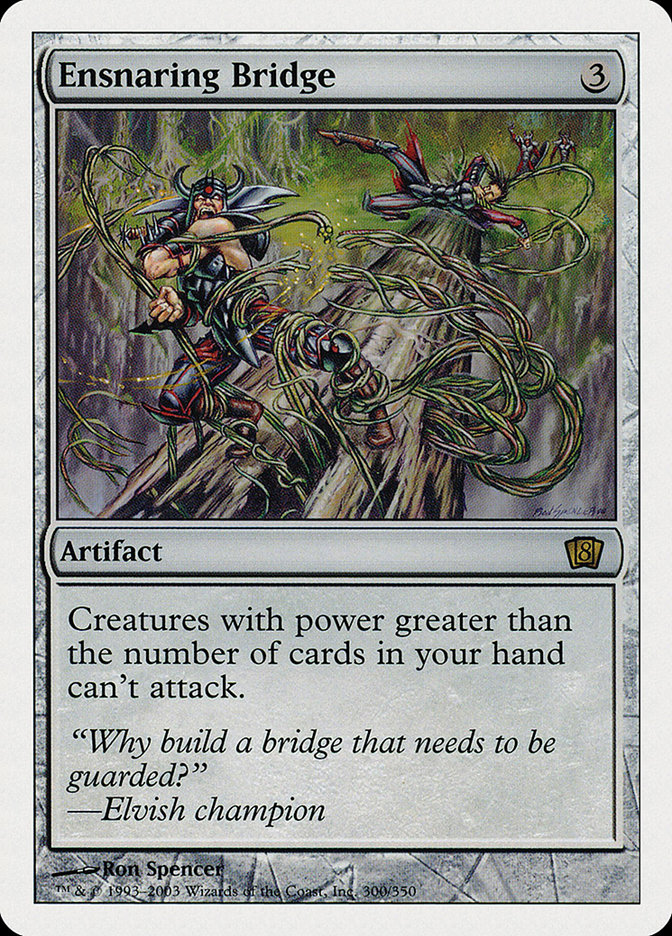Leading up to #GPPitt, I spent most of my testing time on Lantern Control, with a bit of time trying Gaudenis’s Collected Company deck that I recorded a video with last week. Things started out well with the
Collected Company deck, but then I hit a bad run and went 0-5 in a league and just decided to give up. The night before the GP, I was undecided on what to
play. While I’d put the most time into Lantern Control, I had solid but not amazing results with it online (20-12), but I’d never played a timed match in
person with the deck, and I had no idea if finishing matches would be a problem. I knew Zac Elsik had obviously managed to finish his, but I’d also heard
that he plays the deck very quickly, and I didn’t know for certain that I could.
I still liked Amulet Bloom, which Justin had been working on, and while he was still winning a lot more than he was losing, he was starting to lose more
often to the decks with Kolaghan’s Command that can recur Fulminator Mage, like Jund and Grixis. We had some ideas to address that, like trying Obstinate
Baloth, but no great way to address the real problem: that people just had more mana denial and a better idea of how to use it now than they used to. It
was cutting into Amulet Bloom’s win percentage. On top of that, we’d seen a lot of Amulet Bloom online and heard that it was popular in the grinders, which
lead to concerns that decks that prey on Amulet Bloom would rise to the top, that it would be correct for people to have more hate in general. That also
encouraged us to play Lantern Control, because it has an excellent matchup against Amulet Bloom.
Tom Martell suggested that Storm was likely very well-positioned at the moment, as there’s very little dedicated hate for it and particularly little
graveyard hate in general. Picking up Storm was very much in line with my basic approach to Modern, which I summarize as, “play the most unfair deck people
aren’t prepared for/paying attention to.” People are definitely expecting Amulet Bloom at this point, and definitely not expecting Storm. So I put Storm
together Friday night and tried a few games with it. I felt like the deck just isn’t objectively good enough. It’s fine, but just not quite where I’d want
it to be, and I’ve had really bad experiences playing it in GPs before, so I just decided I didn’t want to go there.
I stayed up until almost 5:00am without really deciding whether I should play Amulet Bloom or Lantern Control. I think both decks are very good, and I felt
reasonably comfortable playing either, except that I had serious time concerns about Lantern Control. I also had a lot less confidence in Lantern Control,
not that I didn’t expect it to do well, but that I didn’t have enough data to really know how good it is for certain. Ultimately, I decided I’d have more
fun and learn more if I played Lantern Control. Moving forward, I wanted to know if it’s a deck I should think about playing, and the fact that I couldn’t
learn that by playing on Magic Online, because my biggest question at this point was about how it functions in a timed physical tournament, definitely made
me want to take advantage of this Grand Prix as an opportunity to figure that out, even if it felt a little weird to use a Grand Prix (rather than
something like a local tournament) to see if I could finish matches.
Despite liking the deck, I had absolutely no confidence that I would do well in this tournament. I knew that Lantern Control has a horrific matchup against
Jund, and that might just end up being a popular deck that I have to play several times, and I was also worried that I might just not finish matches.
Every deck has vulnerabilities though, so I ended up submitting the following:
Creatures (3)
Lands (17)
Spells (40)

This is basically Justin’s list, which I know was modified very little from Zac Elsik’s list. I’m not sure that it’s perfect, but it felt pretty close. The
cards I’m least confident in are the fourth Mox Opal, the manabase in general–I don’t know that those are the perfect lands, but I never had problems. I
think there’s a reasonable chance the third Ghost Quarter would be good–and the Ancient Grudge in the sideboard. Overall, I don’t think there’s a lot of
flexibility here.
While this deck is rumored to have a bad matchup against Burn, that hasn’t exactly been my experience. I think the Burn matchup is fairly even. I think
Jund is the only really awful matchup, but I’ve also lost to Grixis and Sultai if they have a lot of cards like Kolaghan’s Command, Abrupt Decay, and
Maelstrom Pulse (Jund is the worst by far, because it has all of those and all of its threats are particularly ideally suited to the matchup). I think
Grixis and Sultai are close matchups.
I felt pretty good against most dedicated creature decks, like Infect, Collected Company, and even Twin. Affinity is similar, but the scariest of those,
because they have the best counterplay.
I similarly felt good against most combo, especially graveyard decks like Hulk Footsteps and primarily creature-based combo like Amulet Bloom. Scapeshift
and Ad Nauseam are a little more threatening, but I think still ultimately favorable. The combination between discard and library manipulation of their
deck makes assembling combos or finding their few win conditions very difficult, and Surgical Extraction can often just end the game.
As for the actual tournament itself, I’m going to go for a slightly abstracted tournament report, going over what I played, but not worrying about the
specific order or anything.
The deck I played against the most was G/R Tron, which is good, because the matchup against it is both favorable and very interesting and fun to play. They
have a lot of different kinds of threats that you can answer in a lot of different kinds of ways, and you need to decide exactly how you want to fight each
thing they’re doing.
Ideally, you’ll be able to use Ghost Quarter or a mill effect to get a Tron piece in their graveyard, and then Surgical Extraction it so that they can
never get Tron together, but sometimes, you can’t find a Surgical Extraction and that doesn’t happen. Fortunately, this deck is always capable of choosing
between denying mana and denying threats, and if you can’t stop them from getting a lot of mana, you can switch to trying to stop them from doing anything
useful with it.
Their most threatening card is Oblivion Stone, which you can address with Pithing Needle, or you can try to stop them from drawing one. Pithing Needle is a
great solution, but the problem is that it’s great against them and you can only Needle so many things. If you’re not fighting their mana, it really helps
to be able to Needle Eye of Ugin so that you don’t have to try to stop them from drawing Sylvan Scrying or Expedition Map, because Ulamog, the Ceaseless
Hunger is a big problem. If you can get them to play Eye of Ugin too early, you can Ghost Quarter it, which is great because it saves you a Needle. Also,
if you can randomly mill it, you can stop worrying about their ways to find it, except that you have to make sure they can’t save a land search effect and
then find a way to get Emrakul, the Aeons Torn into their graveyard to shuffle Eye of Ugin back in, and then tutor for the Eye, and then start grabbing
Ulamogs.
Karn Liberated is a huge threat that functions very much like Oblivion Stone, although you can sometimes win if they get to activate it once, which is
harder with Oblivion Stone. Ugin, the Spirit Dragon, on the other hand, matters very little. The first two abilities do little to nothing. Yes, eventually
they could burn you out, but only if you don’t have a Spellskite and a blue mana. The main thing it’s doing is threatening to draw seven cards. It’s
possible to get to the point where that doesn’t matter, but for the most part, you do need to Needle Ugin, but you have a couple of turns after it comes
down before you have to do that, so you generally have plenty of time to find one.
Emrakul makes decking them a little harder, but between Pyxis of Pandemonium and Surgical Extraction, combined with the potential to just strand it in
their hand, that’s not a major concern–at least one of my opponents even sided it out against me. Relic of Progenitus is another card that matters. When
it’s on the battlefield, you can’t resolve a Surgical Extraction and it fights Academy Ruins. Between this and their Ghost Quarters, sometimes you give up
on Academy Ruins, but not always. Chromatic Star, Chromatic Sphere, and Ancient Stirrings are all cards you really don’t want to let them draw, because
they make it harder or impossible to stop them from getting other important cards. Chromatic Star is the least threatening of these because the draw is a
trigger that you can respond to, but Chromatic Sphere draws as a mana source, so if there’s ever a card on top of their library that they want when you
have Lantern of Insight on the battlefield, you won’t be able to stop them from getting it, which is a huge problem. You may need to use a removal spell on
a Chromatic Sphere when the top of their library isn’t threatening just to stop them from using it at the right time later.
So basically, there’s a lot going on, and how you prioritize a lot of different things matters a lot, so the games are engaging. This can be contrasted
with playing against something like Naya Company, where you just get an Ensnaring Bridge down and needle their Qasali Pridemages and see how long it takes
them to realize they should concede.
I played against G/R Tron three times and won all three matches. In one of them, my opponent likely could have gotten a draw instead–we started the third
game with six minutes left on the clock, and he conceded when there was one minute left. He only had three colorless lands on the battlefield, and I had
enough lock pieces that it was clear he’d never cast a spell. I won another one of those matches 1-0-1, so time can definitely be a concern in the G/R Tron
matchup because there’s so much going on.
The only other deck I played against more than once was Jund, and I very luckily managed to go 1-1 against it. The problem with this matchup is that you
have very few answers to Dark Confidant, and you’re extremely unlikely to win if it’s on the battlefield. On top of that, Tarmogoyf is always huge, and
they have enough answers to Ensnaring Bridge that it’s very hard for you to stop it from attacking. Scavenging Ooze isn’t as big of a problem as either of
those, but attacking your graveyard matters, so all of their threats are very effective. Once that’s combined with a surprisingly large amount of artifact
removal and discard, it’s just very hard to keep any kind of lock in place against them. Welding Jar is critical, and if you can get enough of those down,
sometimes they’ll just lose to Ensnaring Bridge, which is roughly how I managed to win, but it’s still a matchup I think is close to hopeless.
My next loss came from Affinity. For the most part, I think this matchup is pretty good. Once you get Ensnaring Bridge down, they need a zero power
creature combined with Cranial Plating and the ability to equip it at instant speed or Arcbound Ravager or Signal Pest to damage you. Pithing Needle is
great, and you generally have plenty of time to deal with their Signal Pests. The losses were close, basically dying one turn before locking my opponent
out both times, although the third game may not have been as close as it looked, because my opponent revealed that he had a second Ancient Grudge at the
end of the game–but his draw was unusually excellent, containing multiple Ancient Grudges and a very fast clock.
The other deck I lost to was Grixis Control, and both games I thought I’d basically established control, but my opponent’s last card let them kill my
Ensnaring Bridge to finish me. This is another interesting and challenging matchup that I think is pretty close, and I’m not sure who has the edge.
I beat Grixis Twin once, but my opponent definitely could have gotten a draw if he’d played the second game better–he had Keranos on the battlefield at
one point, and just forgot about a Spell Snare in his hand when I played Spellskite because it hadn’t been able to do anything for so long, and the
Spellskite barely let me weather the storm from Keranos, and I won the game at one life. Twin is another matchup where there’s a lot of play, especially
after sideboarding, and time can easily be a real issue.
I beat Burn, but mostly because his draws in the second and third games were very weak, while mine were great, including early access to key sideboard
cards like Leyline of Sanctity, Sun Droplet, and Pyroclasm.
The other matchups were all pretty easy–Naya Company, Hulk Footsteps, and Amulet Bloom. Naya Company just has an incredibly hard time beating Ensnaring
Bridge. Hulk Footsteps struggles against Grafdigger’s Cage, Surgical Extraction, and Pithing Needle, each of which makes their combo impossible, and then
Ensnaring Bridge shuts down their backup plan. In the first game, I locked my opponent on one mana after he started the game with a three-card hand, and in
the second, I got Pithing Needle and Ensnaring Bridge down, and then just had to make sure he couldn’t find his one Hurkyl’s Recall.
The Amulet Bloom player kept playing after I’d dealt with his way to win, hoping that I’d play Academy Ruins, which he could then Vesuva to try to get his
Engineered Explosives back. He conceded when I drew and didn’t play my Academy Ruins, but I don’t really think the plan would have gotten him anywhere
anyway, since I could have just milled the Engineered Explosives every turn.
So I finished 12-3 (9-3 in matches played, of course), and had a good time playing Lantern Control. Time is a concern, but it’s not insurmountable (for
what it’s worth, I’ve never timed out on Magic Online with the deck, but my opponents almost never concede, hoping I will time out, and I almost always
finish with under five minutes on my clock). While playing on Magic Online, I’ve encountered far more complaining than while playing other decks, so it
will be interesting to see if anything is done to address this deck, like banning Lantern of Insight or Ensnaring Bridge, not because the deck is too
powerful but just because people hate playing against it (though I personally didn’t experience any negativity related to that in person).
I’m happy with my choice and look forward to playing it again, though I also need to try my newest TeamUltraPro teammate Corey Burkhart’s Grixis Control deck, since Jace, Vryn’s Prodigy is awesome, and it
might be useful to get a little experience playing a fair deck in Modern again at some point.






